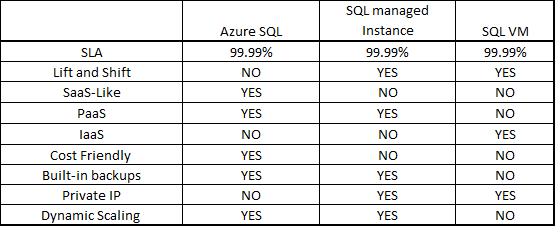EMAIL SUPPORT
dclessons@dclessons.comLOCATION
USAzure SQL Database
First release of Azure SQL Serve was in 1989. SQL Server is a world class DBMS system capable of running any kind of workload.
Below are the three Azure SQL database platform Options which are used in different scenarios.
- Azure SQL
- SQL managed Instances
- SQL Virtual Machine
Each option has specific use-case based on cost, migration options, maintenance, and SLA. Once you decide the platform, then you need to select the tier like General purpose, Business Critical, Hyperscale, basic , standard , Premium.
Azure SQL runs on PaaS model, where you don’t have access to database server and only have access to database. This model is same with SQL managed Instance.
SQL managed instance is more like SQL Server installation on-premises than a Azure SQL Database. Means migrating existing database to Azure will be easier because most SQL feature available with on-premises are also available with SQL managed instances.
SQL Virtual Machine is IaaS model. Below table explains more detail about these three platforms.

Azure SQL database based on PaaS model is cost effective than more customizable SQL machine, whereas SQL Managed instance falls between two. Cost includes direct cost of software and compute resource. If you use SQL VM, additional support cost, maintenance cost is not included, as you are responsible for configuration of backups and patches. In this you can scale SQL VM virtually and SQL managed Instance and SQL VM platform gets the private IP address that can be accessed from on-premises.
Both Azure SQL and SQL Managed Instance have built-in capability for backups. Azure SQL does not have private IP, but others two have, which allow connectivity through a VPN gateway, Express Routes.
It is also possible to set firewall rules and configure service endpoints to restrict access to database via public IP of the Azure SQL Database.
Pricing Models and Limits
In Pricing model, there are two most prominent purchasing model available:
- DTU (Database throughput unit)
- vCore
Other model like Elastic database throughput unit (eDTU) are cost model used when running a database in an elastic pool.
DTU pricing model was the first pricing attempt by Microsoft for this offering. It was based on an OLTP industry benchmark and remains the model when running in the basic, standard , premium tiers.
DTU pricing model is a combination of compute/memory/storage and I/O resource consumption. The primary goal is to provide a fixed amount of compute resource at fixed price, while providing a consistent level of performance and stability, preemptively calculating how much of each resource (CPU, memory, IOPs) a database needs in advance and then translating that in to number of DTUs your database requires.
DTU pricing model is fixed, means when you database consumption hits the threshold, the compute gets throttled.





LEAVE A COMMENT
Please login here to comment.